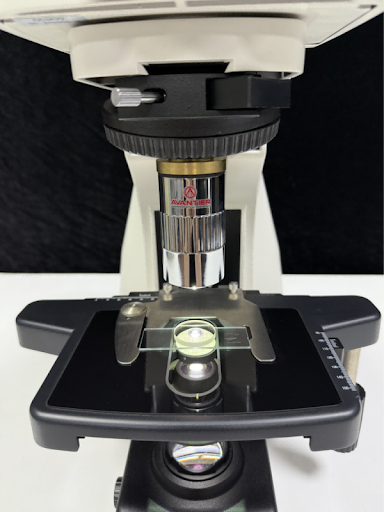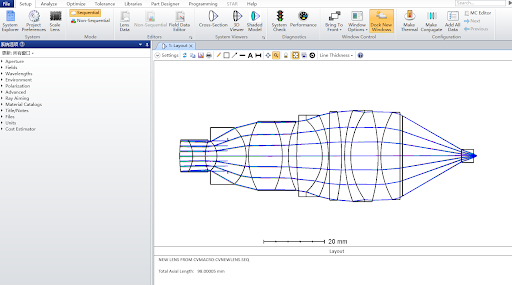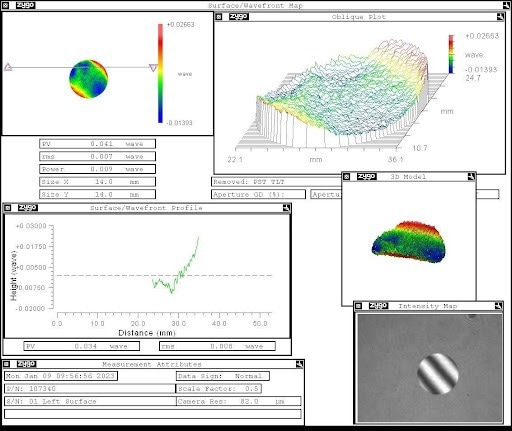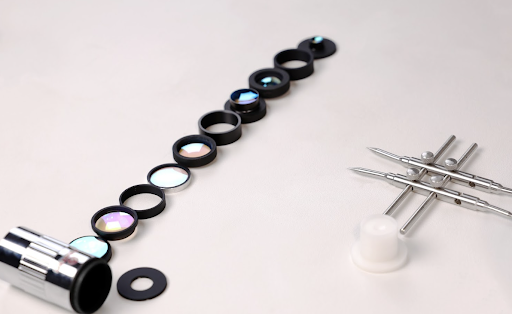The objective lens is designed to deliver high resolution, a broad field of view (2500 μm × 400 μm), and long working distance while minimizing aberrations across both UV and visible wavelengths.

A long working distance, large numerical aperture microscope objective mounted on the microscope rack. Image Credit: Avantier Inc.
Multi-Wavelength Aberration Correction
To decrease chromatic aberration, a cemented triplet configuration utilizing crown and flint glass was adopted. The three lens groups were individually tailored for 397 nm, 400 nm, and 632.8 nm wavelengths, attaining:
- Chromatic aberration ≤ 0.02λ
- Correction of spherical aberration, coma, and astigmatism via asymmetric curvatures and lens tilt optimization
RMS wavefront aberration ≤ 0.05λ across the spectral range
Telecentric Optical System
A telecentric imaging path was adopted to guarantee consistent UV illumination, ensuring telecentricity remained within 5 mrad. This approach minimizes intensity fluctuations due to object displacement, which is crucial for ion array excitation.
Extended Working Distance with High NA
A three-stage optical setup was necessary for achieving both NA = 0.49 and WD ≥ 52 mm:
- Front: Biconvex lens for incident pupil expansion
- Middle: Meniscus lens to compensate for field curvature
- Rear: Plano-convex lens for optical path shortening
This configuration balances performance and integration adaptability within vacuum chambers and optical tables.
Optimization of Transmission and Distortion
- High-transmittance optical glass (≥82% at 397 nm)
- Multilayer AR coatings (reflectivity ≤ 0.5%), resulting in total transmission ≥85%

Optical design of long working distance and large numerical aperture microscope objective. Image Credit: Avantier Inc.
Production Process: Achieving Ultra-Precision Tolerances
The objective lens comprises 12 spherical components produced to precise tolerances.
Lens Production
- CNC spherical grinding with instantaneous compensation ensures curvature precision within ±0.001 mm
- Polishing with nano-alumina abrasives achieves a surface roughness of Ra ≤ 0.01 μm and flatness ≤ λ/10
- Bonding with UV-cured adhesive in a Class 100 cleanroom maintains coaxiality ≤ 0.002 mm and bonding parallelism ≤ 5
Thickness and Centering Accuracy
Laser interferometry guarantees:
- Thickness deviation ≤ ±0.002 mm
- Focal length deviation ≤ 0.1 %
Coating and Assembly
- AR coating using vacuum magnetron sputtering with 11/9/7-layer stack designs for 397/400/632.8 nm
- Temperature- and humidity-controlled lens assembly:
- Coaxiality ≤ 0.005 mm
- Center deviation ≤ 0.01 mm

Lens flatness PV=0.041wave(λ=632.8 nm). Image Credit: Avantier Inc.

All parts and assembly tools of the lens. Image Credit: Avantier Inc.
Application in Ion Trap Systems: Improved Optical Performance
Dual Function: Laser Excitation and Fluorescence Imaging
- Field of view fully encompasses standard ion arrays (2000 μm × 300 μm)
- Laser intensity uniformity within ±3 %
- Fluorescence collection efficiency enhanced by 40% over NA=0.3 designs
- Combined with ≥85 % transmission, the signal-to-noise ratio improved by 60 %
High-Fidelity Imaging
- Imaging distortion ≤ 0.2 % → positional error ≤ 5 μm
- Spot size ≤ 1.2 μm, allowing resolution of ions ≥2 μm apart
- Performance assessments resolved 10 Ca+ ions with positional repeatability of ±0.3 μm
System Integration and Dependability
- 52 mm working distance accommodates ample space for trap electrodes and vacuum chamber windows
Multi-band correction eliminates frequent recalibration during testing
Conclusion
This high-NA, long working distance microscope objective is a robust optical instrument for quantum computing, atomic physics, and UV-based fluorescence imaging systems. This system establishes a benchmark for novel microscope objective design in intricate lab applications by integrating cutting-edge optical engineering, ultra-precision manufacturing, and practical experimental performance.

This information has been sourced, reviewed, and adapted from materials provided by Avantier Inc.
For more information on this source, please visit Avantier Inc.